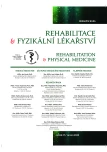The Influence of Phy-siotherapy for Female Urinary Incontinence
Authors:
I. Hurtíková 1,2; A. Repková 2
Authors‘ workplace:
Všeobecná fakultní nemocnice, Praha
1; Fakulta ošetrovateľstva a zdravotníckych odborných štúdií, Slovenská zdravotnícka univerzita v Bratislave
2
Published in:
Rehabil. fyz. Lék., 27, 2020, No. 2, pp. 87-91.
Category:
Original Papers
Overview
Paper monitors the influence of physiotherapy on stress urinary incontinence in women as a result of dysfunction of pelvic floor muscles. It monitors whether: targeted physiotherapy reduces or mitigates incontinence, physiotherapy is a more effective method of treatment of first and second degree incontinence than surgical treatment. It compares two methods of treatment: physiotherapy and surgical treatment. The evaluation uses subjective data from standardized questionnaires with pre - and post-therapy data. The results suggest that targeted physiotherapy reduces the degree of incontinence or alleviates its manifestations Conclusion: Physiotherapy should be the first-line treatment for stress urinary incontinence, especially if it is an incipient state or a lighter degree of incontinence..
Keywords:
Physiotherapy – stress urinary incontinence – Ostrava concept
Sources
1. BØ, K.: Pelvic floor muscle training is effective in treatment of female stress urinary incontinence, but how does it work? International Urogynecology Journal and Pelvic Floor Dysfunction, roč. 15, 2004, č. 2, s. 76-84.
2. DUMOULIN, C., HAY-SMITH, E. J., MAC HABÉE-SÉGUIN, G.: Pelvic floor muscle training versus no treatment for urinary incontinence in women. European Journal of Physical and Rehabilitation Medicine, roč. 44, 2008, č. 1, s. 47-63.
3. HANUŠ, T.: Stresová inkontinence moči u žen a možnosti její farmakologické léčby. Urologické listy, 2005, roč. 3, č. 1, s. 56-62. ISSN 1801-7584,
4. HOLAŇOVÁ, R. et al.: Srovnání efektu individuální a skupinové fyzioterapie u pacientek s močovou inkontinencí. Rehabilitace a fyzikální lékařství, roč. 22, 2015, č. 1, s. 22-25.
5. HOLAŇOVÁ, R., KRHUT, J.: Fyzioterapeutické přístupy v konzervativní léčbě močové inkontinence. Urologie pro praxi [on-line], roč. 11, 2010, č. 6, s. 308-309. Dostupné na internetu: <https://www.urologiepropraxi.cz/pdfs/uro/2010/06/04.pdf>.
6. KOLÁŘ, P.: Rehabilitace v klinické praxi. 1. vyd. Praha, Galén, 2010.
7. MARTAN, A., MAŠATA, J., ŠVABÍK, K.: Nové operační a léčebné postupy v urogynekologii: řešení stresové inkontinence moči, defektů pánevního dna a OAB u žen. 2. vyd. Praha, Maxdorf, 2013.
8. PRICE, N., DAWOOD, R., JACKSON, S, R.: Pelvic floor exercise for urinary incontinence: a systematic literature review. Maturitas the European Menopause Journal., roč. 67, 2010, č. 4, s. 309-315.
9. ŽIAKOVÁ, E, BUZÁŠOVÁ, G., SLÁDEKOVÁ, N., KRESÁNEK, J.,HAVLOVÁ, J.: Využitie balančných pomôcok v kinezioterapii pacientov s koreňovým syndrómom v lumbálnej oblasti. In Studia Kinanthropologica, roč. 17, 2016, č. 3, s. 501-511. ISSN 1213-2101.
Labels
Physiotherapist, university degree Rehabilitation Sports medicineArticle was published in
Rehabilitation & Physical Medicine

2020 Issue 2
- Hope Awakens with Early Diagnosis of Parkinson's Disease Based on Skin Odor
- Deep stimulation of the globus pallidus improved clinical symptoms in a patient with refractory parkinsonism and genetic mutation
Most read in this issue
- Piriformis Syndrome and FAIR Test from the View of Magnetic Resonance
- Evaluation Dynamic Postural Stability – Creation of Reference Values for a Common Young Population in the Czech Republic
- The Influence of Phy-siotherapy for Female Urinary Incontinence
- Practical Use of PolyEMG in Rehabilitation. Poutpatient’s. Surface Electromyography (SEMG) and EMG Biofeedback
